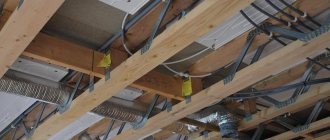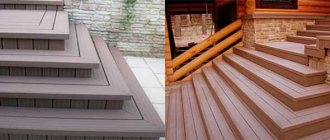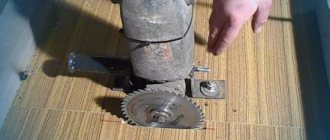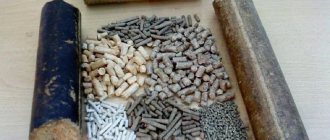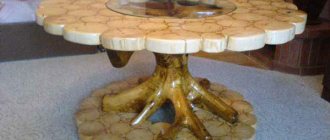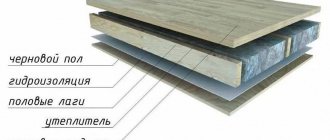Work associated with the formation of dust, the release of toxic gases, and fumes requires the installation of an exhaust system in the workplace and room. In most cases, do-it-yourself ventilation in the workshop is the most affordable way to solve the problem.
There are various options for constructing air exchange systems. We will help you navigate their diversity and consider the features of building ventilation for each type of workshop. Let's look at the most effective and affordable options for self-installation.
Principle of operation
You can do a cyclone-type chip ejector with your own hands only after determining the basic principles of operation. The features include the following points:
- A corrugated hose of small cross-section is connected to the main body, which concentrates and enhances traction. The tip may have different attachments, it all depends on the specific task at hand.
- At the top of the structure there is a motor, which is directly connected to the impeller. During rotation, the air is discharged, thereby creating the required thrust.
- During suction, the chips settle in a special container, and the air is discharged through a special pipe on which a coarse filter is installed.
- A fine filter is also installed at the outlet pipe, which traps small particles and dust.
Operating principle of a cyclone
In general, we can say that the operating principle of cyclone-type chip ejectors is quite simple, due to which the design is characterized by reliability.
As a result…
DIY ventilation systems for the workshop are ready. Ventilation is a must in every professional workshop; it removes harmful fumes, poisonous gases, as well as dust and dirt that have settled in the air. Additionally, ventilation creates an air flow and displaces exhaust air from the room with new air from the street. I talked about three ways to create a homemade ventilation system for various purposes. What type to make for your needs is up to you to decide.
Question
Write in the comments why do you think dispersed dust is so dangerous for humans?
Types of chip ejectors
Almost all models of cyclone chip ejectors are similar. In this case, the main mechanisms, for example, the engine or the cyclone system, may differ slightly, which determines the main classification. All cyclone type chip extractors can be divided into several categories:
- For household use.
- Universal.
- For professional use.
When choosing a model for a home workshop, you should pay attention to the first two groups of equipment. This recommendation is due to the fact that their cost should be relatively low, while the performance will be sufficient.
Professional chip suction
If you frequently carry out work in the workshop, there is a large amount of shavings, and if you are providing professional cleaning services for workshops and other premises, you should consider when choosing cyclone-type chip ejectors from the professional group. This is due to the fact that it is characterized by higher performance and reliability, and can withstand long-term use.
Catchers and other components
In conclusion, it is worth talking about those elements that are given the least importance, although their importance cannot be overestimated. We are talking about all kinds of bells, receiving funnels and casings, as well as the appropriateness of their use with this or that type of equipment.
As already mentioned, when working on grinding machines, an impressive amount of microscopic dust is generated. When connecting an aspiration system to such equipment, the main emphasis is on capturing the smallest particles, while large chips can freely fall to the floor and then be collected manually or with a vacuum cleaner. If you use receiving funnels in such cases, the air flow from the working body itself will create turbulence and the capture of fine dust will become possible only if the suction is strong enough. The most reasonable thing to do would be to eliminate the suction bell and place the suction pipe in close proximity to the treatment area.
But where sockets are really needed is in milling, turning and sawing machines, as well as on planing equipment. Here the main emphasis is on drawing in large chips and sawdust, so the best option would be to equip the working area with a receiving casing that most accurately follows the shape of the working body and fits as tightly as possible to stationary surfaces. Please note that the optimal total cross-section of the gap on all sides of the casing should be 1.5–2 times larger than the nominal diameter of the channel through which the machine is connected to the dust removal system. For large values, it is recommended to use sealing brushes, this is especially important for milling equipment.
rmnt.ru
Cyclone type chip suction device
Most models resemble a regular vacuum cleaner, which, due to its strong traction, sucks up large and small chips. However, even a powerful and high-quality vacuum cleaner cannot be used to clean the workshop. The main structural elements can be called:
- A flange-type electric motor is installed, the power of which is only 3.5 kW.
- To discharge the air, a fan with a durable and mechanically resistant impeller is installed. It must be large enough to produce the required thrust.
- The cyclone is designed to purify the air that will be exhausted outside. Its device is designed to filter large elements.
- A multi-stage filter significantly increases the efficiency of the procedure. This is due to the fact that at the primary stage, large elements are separated, after which small ones are separated. Through multi-stage cleaning, you can significantly extend the life of the filter and increase its efficiency.
- The lower cyclone is intended for direct collection of chips.
- A collection bag made of durable material is designed to temporarily store chips and other debris that have been separated from the passing air flow.
High-quality models have a sealed body, which is lined with sound-absorbing panels. To control a cyclone-type chip extractor, an electrical or mechanical unit is placed; there must be a special hole for connecting a corrugated hose with a nozzle.
It is not difficult to make a cyclone-type chip extractor with your own hands, since it is in many ways reminiscent of a conventional vacuum cleaner with a large number of filter elements and high power. The woodworking cyclone device is characterized by high reliability; if the operating instructions are followed, the device will last a long time.
Assembly of the working unit
Tubes are inserted into the holes made and secured with screws. To ensure the tightness of the joints, they are welded with hot glue using a hot glue gun.
It is best to use corrugated hoses for connecting to a vacuum cleaner and the inlet for removing construction waste, designed specifically for this type of household appliance.
If it is necessary to extend the pipe outlet, for example, to lead it to the machine across the workshop, you can add a piece of smooth plastic pipe. But, it must be taken into account that in such pipes there is an accumulation of static electricity under the influence of the speed of particle movement.
This means that it is necessary to either use plastic with a built-in metal wire that goes to the grounding circuit, or wrap the pipe with foil, which is also grounded.
Thus, a DIY construction vacuum cleaner will work in accordance with fire safety regulations and will acquire the safety qualities of a manufactured product.
Another secret to reliable service of a homemade device is to prevent deformation of the housing due to the plug that sometimes forms in the pipe when soft material, such as sawdust, passes through.
The problem can be easily eliminated by inserting several metal frames in the form of hoops into the barrel. This will add weight to the unit, but will keep it from cracking.
Note!
Do-it-yourself charger for a car battery: a step-by-step guide for making the device at home, selecting materials for assembling the structureDIY laboratory power supply | Step-by-step instructions on how and from what elements to build a power supply
DIY antenna for digital TV - photo instructions on how to make simple antennas for digital TV
Design features
In most cases, when making a cyclone chip pump yourself, a low- and medium-capacity motor is installed, which can be powered from a standard 220V network.
More powerful units are equipped with three-phase motors, which can cause quite a lot of difficulties in powering them in domestic conditions.
Among the design features, it should be noted that the impeller is installed to ensure spiral turbulence of the air flow. In this case, heavy particles are dumped into a special container, after which centrifugal force again lifts the air to remove it.
Preparatory work
When making a structure with your own hands, you can save a lot, but some mechanisms still cannot be assembled yourself. An example would be the most suitable motor and impeller. The preparatory stage includes the following actions:
- Formation of an action plan for assembling homemade equipment.
- Searching for a suitable electric motor, checking its condition.
- Selection of other mechanisms that cannot be made by hand.
Chip suction drawing
In a carpentry workshop, much of what is required to create cyclone-type chip ejectors can be made with your own hands.
Tools
Depending on the chosen scheme, a variety of tools may be required. The easiest way is to make the outer casing from wood. It is to this that other elements will be connected. The recommended set of tools is as follows:
- Indicator and multimeter.
- Chisel and other tools for working with wood.
- Screwdriver and various screwdrivers, hammer.
The simplicity of the design determines that it can be manufactured with the most common tools.
Materials and fasteners
The device being created must be light and airtight, and also withstand the pressure exerted by air swirling. To make it you will need:
- The body can be assembled from plywood, the thickness of which is about 4 mm. Due to this, the structure will be durable and lightweight.
- To make other parts, you will also need pieces of wood of various thicknesses.
- Polycarbonate.
- The filter can be taken from a VAZ injection type. Such a filter is cheap and will last quite a long time.
- The engine can be removed from an old powerful vacuum cleaner, the impeller will be mounted on the output shaft.
- To connect the main elements you will need screws, self-tapping screws, bolts with nuts, and sealant.
Plastic housing for cyclone
After finding everything you need, you can start doing the work.
Making a cyclone filter
As previously noted, making a filter is quite difficult; it is best to purchase a cheap, ready-made version. However, it will also require a sealed seat.
The seat is also made of wood. In this case, the main thing is to correctly choose the appropriate diameter of the outlet hole, since too small will lead to a decrease in throughput. There is no need to attach the filter, just create a block for it that will fit perfectly in size.
Creating a retaining ring and a shaped insert
To fix the polycarbonate during the manufacture of the case, wooden rings are required. They must have an internal diameter that provides the required volume of the storage tank. Between the two fixing rings there will be vertical strips holding the polycarbonate sheets.
You can make such rings in a home workshop if you have the appropriate skills and equipment. At the same time, do not forget that they must have high strength.
Installing the Retaining Ring
Assembling the case can begin by placing the locking wheels and polycarbonate sheets. Among the features of this stage the following points can be noted:
- The sheets are fixed on both sides with strips.
- The connection is made using self-tapping screws.
- To improve sealing, slots are created in the lower and upper rings for sheets, after installation of which the seams are sealed with sealant.
Homemade cyclone for vacuum cleaner
After assembling the housing, you can begin installing other structural elements.
Installing the side pipe
In order to eliminate the possibility of rupture of the structure due to clogging of the filter element, a side pipe with a safety valve is installed. To do this, a hole is created in the polycarbonate sheet, which is closed on both sides by the body of the safety pipe.
A rubber gasket should be placed between the wooden planks and the wall; the degree of sealing can be increased by using sealant. The element is secured to the body using bolts and nuts.
Top entry installation
Suction of chips and air occurs from the top of the structure. To accommodate the upper input, a small housing is created in which the pipe from the old vacuum cleaner is placed.
When using a special pipe, reliable fixation of the suction hose is ensured, which, moreover, can be quickly removed if necessary. That is why you should not make it yourself.
Installing a shaped insert
A shaped insert is also required to connect the inlet pipe. It must be positioned so that air containing particles can flow in without difficulty.
Homemade chip sucker
As a rule, the figure is located opposite the fan, due to which the air flow swirls. It is best to seal the seams with sealant, which will increase the degree of insulation of the structure.
Cyclone filter assembly
After creating a housing to house the filter, it needs to be installed in its place. It is worth considering that there will also be electronic elements inside that provide power to the electric motor.
Another pipe is removed from the outer part of the cyclone filter housing. It will be needed to divert the air flow.
Pipeline steel and flexible channels
Both centralized and local aspiration systems require connecting pipelines, through which waste is moved from the capture zone to the filter unit. The list of materials suitable for constructing a pipeline system is very wide.
Initially, flexible ventilation ducts are of greatest interest. They consist of a polyethylene or polyurethane shell reinforced with a spiral reinforcing cord. Flexible pipelines have become so widespread due to their ease of installation, low cost, lack of need to use rotary fittings and the ability to quickly change the system configuration. One of the most important advantages of flexible channels is the smooth rotation of the frame, which reduces the overall aerodynamic drag.
However, flexible piping is not without its drawbacks. We must not forget that there is a fairly strong vacuum inside the channel, especially if the system is connected to a powerful air pump. If most of the outlets of the aspiration system are plugged, the pipeline may simply collapse; such cases are by no means rare. Also, due to their low mechanical strength, ducts are not recommended to be laid on the floor or in areas where they could potentially be damaged. The most budget-friendly representatives of corrugated hoses have an internal ribbed surface, which is why when the aspiration system is operating, the pipeline begins to whistle quite noticeably, while the resistance to air flow increases. They are also very prone to dust sticking to the walls due to the accumulation of static charge.
The advantages and disadvantages of rigid pipelines are exactly the opposite. Yes, in this case, a reliable fastening system is required; there will be more connections, but due to the smooth internal surface of the pipes, there are no blockages, sticking of wet chips and a decrease in flow rate. It is necessary, however, to remember that in terms of cost, a rigid steel will be significantly more expensive than a flexible one, and besides, the equipment connected to the aspiration system will remain immobilized. In view of the latter, a combination of rigid and flexible pipelines is often practiced: a dust removal system line is laid along the ceiling from metal or PVC channels of round or square cross-section, and then, using special branch fittings, a transition is made to corrugated hoses for connecting equipment.
Rules for selecting ventilation for a workshop
Every consumer often wants to get the desired maximum result at a minimum cost. To do this, you must first study all the factors that will help or influence such a result. To select the most optimal ventilation system option, it is necessary to take into account the following components:
- the material from which the room will be constructed;
— cleanliness of the environment.
Another very important component is the required amount. Remember that we recommend not saving on the ventilation system, because this will ultimately affect your comfort, and most importantly, your health. Now let's talk about the types of ventilation in more detail and tell you about their advantages and disadvantages.
Now let's talk about the types of ventilation in more detail and tell you about their advantages and disadvantages.
Forced ventilation
Sometimes a workshop needs a huge number of tide valves. In this case, it is best to give preference to a forced ventilation system. Assembly is carried out on absorbent fans. The ventilation system kit includes a ventilation network and ventilation equipment. Installation of flow-exhaust ventilation allows for the presence of the following components:
- Heater;
- Filter;
- Noise suppressor;
- Air valve;
- Fan.
The ventilation equipment design must include an air intake grille, air distribution devices and air ducts. Air distribution devices should include anemostats, grilles and diffusers.
This is what the forced ventilation operation diagram looks like:
The filter is designed to clean air flows from dust; the heater, in turn, heats the absorbed air if ventilation is used in winter. A heater can be installed, but it is not required. Its action comes from water or electricity. The first option is more expensive, since during installation you need to make a hydraulic connection. When the system has an exhaust hood, and ventilation operates due to the supply and exhaust flow, it is necessary to install a recovery system, which will make it possible to reduce the energy consumption for heating the passing air.
Natural ventilation
A natural ventilation system in production should be implemented in the following cases:
— clean outdoor atmosphere;
— if the building materials include the following elements: gas block, cinder block, wood, foam block, metal, expanded clay block, adobe, monolithic expanded clay concrete, ceramic block.
Natural ventilation of the workshop is a very effective and less labor-intensive method compared to forced ventilation. It is often carried out in separate buildings that are made of metal materials and which often have long gaps between the walls and the roof.
Machines for rotary drawing of metal
To implement the technology, the following types of machines are used:
- Pressing and rolling machines for rotary drawing of metal.
- Rotary forging machines.
- Round cutters.
On manual lathes, molding is performed by the muscular strength of the worker. Used to produce unique products or especially small series. For medium and large series, pressing and rolling (rolling) machines with numerical control are used. Hydraulic or electric drives, controlled by a controller according to a program loaded into the central CNC unit, allow precise control of the force and direction of the clamp, as well as the direction of movement of the roller, including the most complex curved trajectories
Such machines ensure absolute identity of products in a series, which is especially important for jet engine parts and other high-tech products
Scheme of forging on rotary machines
Rotary forging machines allow you to form conical-shaped products from pipes by crimping the pipe with a special tool - a forging die. The peculiarity and main advantage lies in the unique ability to produce products that have:
- the length is many times greater than the diameter.
- along the length, the diameter and opening angle of the cone can be repeatedly changed.
- knurling of stiffeners is required.
Round cutters
Circular cutters are designed for cutting rolled sheets into flat pieces in the shape of a circle or ellipse. Also used are both manual and electro-hydraulic.
The importance of preliminary calculations
Ventilation of the shower is necessary if it is installed in a concrete building or in a wooden house. It prevents the negative impact of high humidity on the integrity of plumbing equipment and building materials.
It is necessary to follow SNiP standards, which will serve for the safe operation of the room in the future. Before equipping a room with ventilation with your own hands, you must have a drawing of the shower stall, as well as the dressing rooms available in the room.
Removing excess moisture helps increase the life of all metal plumbing fixtures and some building materials. For normal human well-being, humidity should not exceed 65%. If this indicator is too high, staying in the shower can negatively affect the health of its visitor.
SNiP standards introduce the concept of “air exchange rate”. It represents the ratio of the volume of air entering or leaving a room to the volume of the room itself. The minimum indicator according to SNiP is 50 m3/hour. For public showers – 75 m3/hour.
The minimum “air exchange rate” according to SNiP in a public shower is 75 m3/hour
